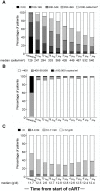Laboratory and clinical predictors of disease progression following initiation of combination therapy in HIV-infected adults in Thailand
- PMID: 22905264
- PMCID: PMC3419679
- DOI: 10.1371/journal.pone.0043375
Laboratory and clinical predictors of disease progression following initiation of combination therapy in HIV-infected adults in Thailand
Abstract
Background: Data on determinants of long-term disease progression in HIV-infected patients on antiretroviral therapy (ART) are limited in low and middle-income settings.
Methods: Effects of current CD4 count, viral load and haemoglobin and diagnosis of AIDS-defining events (ADEs) after start of combination ART (cART) on death and new ADEs were assessed using Poisson regression, in patient aged ≥ 18 years within a multi-centre cohort in Thailand.
Results: Among 1,572 patients, median follow-up from cART initiation was 4.4 (IQR 3.6-6.3) years. The analysis of death was based on 60 events during 6,573 person-years; 30/50 (60%) deaths with underlying cause ascertained were attributable to infections. Analysis of new ADE included 192 events during 5,865 person-years; TB and Pneumocystis jiroveci pneumonia were the most commonly presented first new ADE (35% and 20% of cases, respectively). In multivariable analyses, low current CD4 count after starting cART was the strongest predictor of death and of new ADE. Even at CD4 above 200 cells/mm(3), survival improved steadily with CD4, with mortality rare at ≥ 500 cells/mm(3) (rate 1.1 per 1,000 person-years). Haemoglobin had a strong independent effect, while viral load was weakly predictive with poorer prognosis only observed at ≥ 100,000 copies/ml. Mortality risk increased following diagnosis of ADEs during cART. The decline in mortality rate with duration on cART (from 21.3 per 1,000 person-years within first 6 months to 4.7 per 1,000 person-years at ≥ 36 months) was accounted for by current CD4 count.
Conclusions: Patients with low CD4 count or haemoglobin require more intensive diagnostic and treatment of underlying causes. Maintaining CD4 ≥ 500 cells/mm(3) minimizes mortality. However, patient monitoring could potentially be relaxed at high CD4 count if resources are limited. Optimal ART monitoring strategies in low-income settings remain a research priority. Better understanding of the aetiology of anaemia in patients on ART could guide prevention and treatment.
Conflict of interest statement
Figures


References
-
- World Health Organisation. Antiretroviral therapy for HIV infection in adults and adolescents: recommendations for a public health approach. 2010 revision. WHO Geneva. - PubMed
-
- Walker AS, Gibb DM (2011) Monitoring of highly active antiretroviral therapy in HIV infection. Curr Opin Infect Dis 24: 27–33. - PubMed
-
- Moh R, Danel C, Messou E, Ouassa T, Gabillard D (2007) etal (2007) Incidence and determinants of mortality and morbidity following early antiretroviral therapy initiation in HIV-infected adults in West Africa. AIDS 21: 2483–2491. - PubMed
-
- Thai S, Koole O, Un P, Ros S, De Munter P, et al. (2009) Five-year experience with scaling-up access to antiretroviral treatment in an HIV care programme in Cambodia. Trop Med Int Health 14: 1048–1058. - PubMed
Publication types
MeSH terms
Substances
LinkOut - more resources
Full Text Sources
Medical
Research Materials

